“They halted, then, and called out to each other. As Nausicaa, daughter of valiant Alcinous, commanded, they found Odysseus a sheltered spot. They set out a tunic and cloak for him to wear, and smooth olive oil in a golden flask, and invited him to bathe in the running stream”.
The Odyssey. Book 6.
Part I
Early morning on a 2012 late January Sunday, the gang of laborers appears down the slope. They are young people of the area, no foreigners among them. Thirteen people including the foreman, named José Francisco, are ready for one of the last days of the year’s harvest. The infantry is equipped with shaking mechanical machines, which they engage in the thick branches of the olive tree to knock it down. The engine, similar to that of a chainsaw, starts shocking for a few seconds; the tree trembles violently. The flickering of the sunlight on the silvery undersides of leaves accelerates spasmodically. The olives fall and, from behind, several rakes appear to put a reddish dust cloud with olives, stones, dirt and leaves into black baskets. Beyond them, a tractor waits.
The harvest has been easy this year. It did not rain during the winter and it is also expected that the final product will be good. “The quality is achieved by picking olives early, not as delayed as usual”, says foreman José Francisco. “When it rains, the olive falls down to a mud mixed with all kinds of products; there’s no way to get good oil out of that”.
But there is a setback. José Francisco repeats an old mantra of the olive growers: “If it does not rain this winter, there won’t be any harvest next year”. 2013, the foreman predicts, “will be catastrophic”.
Walking up the hill to the town of Baños de la Encina, in the foothills of Sierra Morena, one can see, with stupor, the raw reality. In the middle of the plain, a thin cypress stands out as a skyscraper over thousands and thousands of olive trees scattered for miles around.
With 570,822 hectares of farmland, olive groves occupy 83% of the agricultural area in the province of Jaén and almost 45% of its total land area. The 66 million olive trees of Jaen has named it “A sea of olives” as the favorite expression used to describe the landscape. However the olive trees awake a false idea of uniformity. Stepping closer the trees reveal important differences.
For instance, you have to look at whether the olive tree is surrounded by an irrigation pipe. “The olives were traditionally dry-farmed; if it rained, great, and if not, then you had to cope with that. But now it is all done with modern irrigation, by drip” says Juan Manuel Matés, professor of Economic History at the University of Jaén and author of several publications on the olive economy.
When Spain joined the European Economic Community in 1986, olive trees were already a major crop in the province of Jaén, which stretches throughout North-Eastern Andalusia. 25 years ago, olive trees only occupied 65% of the arable land.
“Before, there used to be also cereals, and in the Jódar area there was a lot of esparto grass”, says Mates. He considers to factors to have contributed to the olive expansion -– cheap migration labor and the European agricultural subsidies (CAP).
The Common Agricultural Policy of the EU delivers subsidies to around 100,000 beneficiaries in the province. The vast majority of these are olive oil farmers who are substantially dependent on the CAP-subsidies. Matés dismisses that any other crops have had a chance to compete with olive oil.
“Cereal cultivation has not disappeared, but it has been greatly reduced, partly because it cannot compete with cereals imported from abroad. It’s a matter of supply and demand. Eventually people saw that it was more effective to plant olives. The crop is safer and has gained in value these years”.
The magnitude of the last decades of investments towards olive production in Jaen can be found in the irrigation web below the soil of the olive trees. In 1986, only 11% of olive groves in Jaén were irrigated whereas the large majority of 89% were dry-farmed. Twenty years later, the irrigated area had more than tripled from 52,000 to 183,000 hectares. In 2008, one in three olive trees of Jaén were irrigated and so the region has become massively tailored towards olive oil production as the primary income generating crop. A situation Matés blames for causing “very common illegal taking of water from rivers, wells or aquifers”.
The European Union however see dark clouds on the horizon. According to recent projections from the EU, up to 20,000 hectares of rain fed olive groves is estimated to disappear in Spain by 2020. This however can get much worse, as experts point out that these estimates fail to take into account that current European subsidies for olive groves are set to expire by the end of 2013. Matés raises doubt if olive groves can remain profitable without the CAP as financial supplement. Instead he suggests that a likely solution for traditional olive groves could be “to be taken over completely by large olive companies”, which would put them into intensive cultivation.
Spain currently has about 700,000 hectares of irrigated olive grove and 1,8 million hectares of rain fed trees – where the traditional olive grove fits. Despite the remarkable difference in surface, in 2011, 52% of the olive oil produced in the country came from irrigated olive grove, according to EU data. In 2004, irrigation contributed only with a 33% of the oil.
“Of course, the mountain olive trees are doomed to disappear. I hope they do not uproot all of them because they have a very important role in holding soils” says Joaquín Muñoz-Cobo, Professor of Vertebrate Zoology at the University of Jaén, and olive grower himself. “The olive trees of the plain, with beautiful old trunks, have also an axe above them. In both cases, unfortunately, dry plantations will be replaced by more productive and cheaper olive groves”, says the professor.
Biologist Antonio Céspedes has his office in a mill near Baños de la Encina. The mill belongs to six entities (two small cooperatives and four individuals) comprising the cooperative Nuestro Padre Jesús del Llano. On the facade of the building, a white sign says in Spanish: “European Agricultural Fund for Rural Development: Europe Invests in Rural Areas”. The latest data published by the Spanish Agricultural Guarantee Fund reveals this cooperative got a EUR 1.060.923 in subsidy in Direct Agricultural Payments in 2011.
Céspedes works as a technician in integrated production. The cooperative pays 10% of the cost of hiring (salary and social security) and the treatments he recommends for diseases and pests such as the ‘olive fly’. However the remaining 90% of the cost is subsidized by the EU. “When someone buys our oil abroad, they get a certificate proving that a technician has been in charge of the exploitation and has supervised the process”, says Céspedes.
In traditional olive groves, before 1986, the trees were planted every ten or twelve meters and their two or three – or even four – trunks, known as ‘feet’, were intertwined. “Mechanization, having a fruit tree with more than one foot, is much more expensive, and it affects the price of the olive”, says the biologist. “The olive trees with one foot are newer and, typically, they are in large estates”. Céspedes outlines the vast differences between the harvest practices:
“Nearby a farm is growing 22,000 one foot olive trees. Two people, one knocking off the trees and the other one loading the tractor with the olives, have gathered everything in 15 days. The cost of harvest in this property has been between 2 and 3 cents per kilo. In the same exploitation, there is a traditional part with three and four feet olives. They have been picking olives for 45 days, and the cost of harvesting them is about 15 cents per kilo. This is happening at the same farm”.
According to the National Statistical Institute (INE), 84% of olive farms in Spain have less than 10 hectares. This group, the small olive groves, occupies more land and, at the same time, is the most threatened because of their low profitability.
Antonio Céspedes predicts a hard struggle for survival for traditional olive farming if most EU subsidies are scheduled to expire. “They are getting olives at 15 cents per kilo and selling them at 24. With that margin they have to spend the rest of the year: watering, fertilizing, pruning trees, and so on. Even today, with subsidies, some farmers are losing money. For this reason many olive trees are already being abandoned”, he says.
Environmental impact
In addition to the illegal taking of water by farmers, or documented contamination of groundwater by pesticides, the exorbitant growth of olive groves in Jaén in recent decades has caused other environmental problems.
Joaquin Muñoz-Cobo was one of the young biologists that, in the early seventies, used to hang around the Faculty of the Universidad Complutense, in Madrid, to learn from naturalism masters such as Francisco Bernis, José Antonio Valverde, Joaquín Araujo o Félix Rodríguez de la Fuente. Those were the years of the creation of the Spanish Ornitological Society and its magazine, Ardeola, of the early, and timid, anti-nuclear protests.
In 1975, Muñoz-Cobo began studying the ecosystem of the olive crops. «A tremendous change has taken place”, says the professor, “first thing I noticed was that, 1983, they started to use herbicides which left behind burned grass and barren soil”.
According to Muñoz-Cobo, “before, with traditional plow, it was thought that the grass provided nutrients to the soil. Suddenly, companies and some agronomists claimed that the grass was bad because it competed with the trees for water and nutrients. So they began to spread herbicides, destroying the herbaceous layer”.
“Something was changing, especially, granivorous birds started to decrease in number of species and density. Then we noticed that insectivores also decreased, as there were fewer insects”.
With just a herbaceous and a wooden layer, the olive grove is a relatively simple habitat. However, it contains a large number of bird species. “Birds are excellent indicators of the health of habitats because they respond quickly to changes in the system”, says Muñoz-Cobo. Essentially, they fall into two groups: granivorous and insectivorous. The latter “come from central and northern Europe, they come down to Jaén during the winter. In September, birds such as the blackcap (Sylvia atricapilla) or the thrush (Turdus philomelos) suffer from an inner transformation that makes them stop eating insects and start feeding on fruit. These species are pre-adapted to the olive grove and they also have a key role in seed dispersal – they are responsible for increased areas of Honey Suckle (Phillyrea angustifolia), Wild Olive and Mastic (Pistacia lentiscus)”, adds the professor.
These same species have occupied the Mediterranean scrubland since the last Ice Age, but something has changed in the last 40 years: “the birds used to find olive groves with a wide variety of fruits and insects because there were plenty of hedges and bushes delineating the plots”, says Muñoz-Cobo. “In the early seventies, when mules were changed for tractors, hedges were removed because they were thought to be a refuge for horrific bugs, snakes, etc. (and they competed with olives). The disappearance of these hedges caused erosion problems”.
For decades, olives have been the only available fruit, “and, according to our collection of birds analysis, the olive fruits alone cannot keep the birds”, says Muñoz-Cobo. This has made the birds go to other ecosystems, such as the mountains, to eat. “In areas where cereals were cultivated, in the past, steppe birds like the grouse (Pterocles orientalis), the great bustard (Otis tarda) or the little bustard (Tetrax tetrax) have declined”.
Antonio Céspedes points out that «monoculture, by definition, reduces biodiversity. It should be desirable that, next to olive groves, there were vineyards or cereal. In Bailén, for example, it was subsidized pulling vineyards off to start planting olives”. Céspedes refers to an EU and Common Market Organisation (CMO) plan to limit the potential of wine production in member countries. It was tempting for they offered farmers an average of 5,000 euros per hectare of vineyards uprooted. In 2011, the area of vineyards uprooted reached almost 100,000 hectares in Spain. Bailén farmers jumped from a subsidy to another, swapping vineyards for olives.
Consequently, not having much diversity in the ecological structure is causing more pest problems. One of the most common is the Bactrocera oleae or ‘olive fly’. Céspedes, who advises farmers on appropriate pesticide treatments, says that “the olive fly is a common pest for which a localized treatment is not effective. It’s better to perform an air treatment, with fumigation on the area where the fly population is”.
In the past, environmental associations like Ecologistas en Acción have criticized this aerial spraying, which Céspedes defends fiercely. “They say we are throwing uncontrolled venom from above, but what it does exactly is to exorbitantly reduce the amount of pesticides in the field” says Céspedes. “When a farmer does a localized treatment he is casting about ten liters of broth per olive. In the field that I control, with 3,500 hectares and 100 olive trees per hectare, we would need around 3.5 million liters of broth. That itself is a big impact and what you get is that the pest moves away. This year we sprayed the entire town of Baños de la Encina with five liters per hectare. In total 17,500 liters. Compare that with the 3,5 million liters. It is much more environmentally friendly, more profitable and more effective”.
Céspedes also notes that the poor economic performance of small productions of traditional olive groves is affecting herbicide or pesticide treatments. «Before, these groves passed three pesticide treatments per year. Today, they pass just one treatment because the farmer cannot afford the rest” says the biologist, suggesting that, from 2013, with the withdrawal of subsidies, this situation can only worsen.
Exodus and comeback
With a staggering unemployment rate of 37 per cent, Jaén is one of the worst hit provinces in Spain. After the bursting of the real estate bubble, many unskilled workers began to work picking olives, a task that was dismissed by many five years earlier. The local seasonal workers who picked olives that morning near Baños de la Encina were a representative sample of what happens in the rest of the olive groves.
In a flat at the center of Jaén, the headquarters of Jaén Acoge, a pioneering association for the care of immigrants who, in recent years, flocked to the region to work as laborers during the olive campaign. Although this year’s campaign had not ended officially when this interview took place, the office was abnormally quiet.
Pedro Gonzalez, director of the association, recalls how a rapid increase in migration two decades ago changed the olive production sector. “When we started our organisation in 1992, we had no seasonal immigrants. Local workers were the only who gathered the olives. In the entire province of Jaén, there were less than a thousand immigrants”. A few years later, the number of immigrants would be around twenty thousand.
Jaén Acoge was the first association to demand a network of shelters for the migrants who started arriving to Jaen for harvesting season. Their goal was soon achieved with the support from olive growers, says González.
“Olive employers pressured councils to create these facilities” in order to provide shelter to the cheap workforce coming from outside.” In 1994, the first five temporary shelters for migrant workers were created. During the first years, the accommodation provided for immigrants was insufficient to host all of them. “In the past, we have had troubles with immigrants arriving one month before the start of the harvest,” says Gonzalez. «Some years a thousand people were sleeping on the streets during the months of November and December, which led to terrible situations”.
In recent years, the number of shelters in Jaén has risen to 24 but, paradoxically, the wave of immigrants stopped abruptly after 2008, when Spain was hit by the crisis. Migration for harvest season has never returned to the pre-crisis level. “There are very few who come to try their luck now”, says González. “Even if they live outside Spain, migrant workers who arrive, have already established contacts locally made from previous years”.
González estimates that the number of migrant workers has decreased by 30 per cent in just a year. “Five years ago Jaen would host around nine thousand migrant workers. This year the province has reached around two thousand”, he says.
During the campaign, Pedro González and other members of the association visit these shelters to meet the mediators. These are long-time seasonal workers, mostly North Africans, who now work as a link between immigrants and the association.
“There is stuff that happens almost every year”, says Gonzalez, “there is some unscrupulous people who take immigrants to the olive grove without a contract or, if they are hired, they are paid half the salary. How many cases? I do not know. I do not think it’s a major proportion, but we must denounce every situation, as we do. There are employers who exploit immigrants by paying them 20 euros per day”. In the last olive campaign, the wage set by the Agricultural Workers Convention was between 54 and 62 euros for a 7-hour working day.
Not giving any specific names, González points out that this type of labor abuse often occurs in “big producers, people who have more than three or four thousand olive trees and need these workers to access remote or inaccessible sites”. In any case, despite reiterating that these are isolated situations, González acknowledges that it is very difficult to eliminate irregularities, since “the immigrant worker cannot sue the employer because, in general, they have no documentation. If they report the situation to the Civil Guard, they can start expulsion proceedings. So we take care of reporting the irregularity, but it is a snake biting its tail because we are not the affected part, so there is no evidence”.
Currently, most of the few jobs offers for immigrants received in Jaén Acoge are seeking Latin American women, for cleaning homes or taking care of children or elderly people. In a sad way, the Spanish economic crisis has resolved the immigration crisis -or rather, has overlapped it. And for the olive sector, this is not a temporary situation: the jobs that are lost will never return. “They’re going to cut costs”, says Muñoz-Cobo, “that will have a significant social impact because the workforce will disappear. The olive tree is a crop that generates a lot of work and moves money, but the trend will be to eliminate it”.
End of splendor?
Financial assistance from the CAP (along with national and regional governments’ plans) has helped to raise a production giant, modernize it and boost the production of oil every year. But the push for the monocultural produce across the south-central area of Jaen has prevented the prosperity of other types of economic activities in the region. Jaén remains the Spanish leader in olive oil – producing more than half of the countrys olive oil, and Spain is the country producing and exporting the most olive oil in the world. Still there experts stresss their deep concern for olive growers’ as the CAP subsidies are heading towards expiration by the end of 2013.
At the Department of Agriculture of the EU Commission Press Officer, Fanny Dabertrand however denied that the CAP was responsible for any increase in the olive oil production. “From the 1998/99 olive oil campaign, the EU support was granted under a system of maximum guaranteed quantities (MGQ), provided to the olive oil production at an European level, in order to stabilize production, not to increase it”, states Fanny Dabertrand in an email.
The olive industry employs more than 100,000 olive growers in Jaén and nearly 250,000 in Andalusia. Mostly, they are small to medium olive grovers, where traditional harvesting is still in practice.
Juan Manuel Mates considers «the excessive fragmentation of cooperatives to be an added problem for the interests of Jaén olive oil is. They are very small and have no operational ability to sell their product abroad». For that reason, their only option is selling to big companies. «The sellers are many entities, cooperatives and private individuals,» also says Cespedes, «but the buyers are only four or five entities: Migasa group, SOS group, Ecosur, Koipe. These entities own the sales market».
«Another factor,» says Mates, «is the limited enterprise culture» of Jaen olive producers. «There is a mentality of ‘these are my olives, give me the subsidy’. There is a kind of conformity». The vast majority of these small and medium producers of Spanish olive oil have not bothered so far in making their product more attractive to new markets such as the U.S. or Asia. Céspedes says that «for cooperatives of Jaén, an easy sell is a bulk sell. I sell in bulk and you bottle it. They call you on the phone and tell you that they want a million kilos of oil at a price. And the tanker comes and takes it».
One of the possible outputs the European Union suggests for them is eco-farming. “The subject of organic olive grove is still emerging, but there are many attempts”, says Muñoz-Cobo. “Ideally olive oil producers should shift in this direction. Green olive oil sells very well, especially in Germany”. Professor points out that, in the month of August, the whole production of green olive oil is already sold already, even before the harvest starts in autumn. “And at a good price because, as the production is much less intensive, the price grows”, Muñoz-Cobo says.
The process for converting an olive grove into an organic grove is long, but transparent. After making a request to the Spanish Ministry of Agriculture, growers must limit the use of certain pesticides for two or three years. Following a few samples of pesticide content in the olives, the grove is legible to receive the certificate of “pre-ecological cultivation” and after additional time a certificate for “Organic farming”. Despite being in early stages many olive growers expect organic olive farming to be the best scenario for overcoming a life after the CAP post-2013. According to the Ministry of Agriculture, Food and Environment, in 2011 there were already 168,619 hectares of organic olive grove in Spain, 33 per cent more than the previous year.
Experts consulted consider that another ecological path for olive growers to be a desirable outcome which should also include the production of other crops. However, Dabertrand recognizes that the European aid scheme to agriculture adopted since 2006 does not favor the transition from conventional organic olive oil procution. “As the payment scheme is dissociated from production, it does not provide an economic incentive for farmers to switch to other crops”, she says.
Within the current CAP framework there are no measures to support farmers’ transition to other kind of work. “However, Andalusia’s Rural Development Plan for 2007-2013 involves measures to promote economic diversification in the region, including the transition from agriculture to non-agricultural activities”, Dabertrand says.
Furthermore, 2012 olive oil prices in Spain reached their lowest in the last 9 years (1,65 euro per liter of lampante and 2,40 euro for the same amount of extra virgin) because of the high production and a decrease in, both internal and abroad, consumption of Spanish olive oil. In some cases, reaching a price that was close to production cost. However, a substantially higher price is expected this year (around 75% more, according to MFAO, the Spanish Futures Market for Olive Oil) precisely because of what the foreman had alerted, that natural law for olive trees. From 1.4 million tons of olives picked in 2012, this year the amount has lowered to 600.000 tons –from which less oil per kilo is to be extracted.
It’s an 800.000 ton deficit and the trouble is that no other country in the world can supply this loss of production. Fortunately, the olive oil producers still have their private storage. When the price of oil is too low, producers have the option of keeping their product in sealed deposits and wait until the demand grows, several months later, and luckily obtain an EU subsidy to pay the storage rent –last year it was 65 cents per ton and day. Private storage “is a double edged weapon”, warns Céspedes, “problem is, you can keep the oil but you still have to pay the farmer. What cooperatives normally do is to pledge the oil, negotiating a price with the bank to get some cash and pay the farmworkers. It is like you had sold the oil, but it’s still in the deposit. If the price finally rises, then it is fine, but if it doesn’t, you lose money and still have to pay the banking interest”.
“Politicians look good when they say ‘we have granted subsidies to private storage, farmers can be calmed’ but reality is the oil price is in its historical lowest, so it’s not an useful tool for us. But this subsidy keeps the trade unions quiet”, says this biologist.
A good harvest, such as the ones in 2011 and 2012, can produce in Jaén a surplus of up to 400.000 tons of olive oil. “It’s good to have reserves as, for the next years, pretty poor harvests are expected”, says Céspedes. Appart from particular deposits, a non-profit organization called Patrimonio Comunal Olivarero rents its deposits so the producers can store their oil there. But, as Céspedes acknowledges, they’re full. Not a single drop of oil is admitted anymore. “In that sense, we have a problem”.
Part II
A bus of Japanese tourists, coming back from the route Ubeda-Baeza, stops in a service station outside Linares. At the strategic gift shop, some women covered with anti-allergic masks hold with curiosity the oil bottles, presented in such a manner, with elegant boxes and dark glass, that even the keenest observer would have mistaken it for malt whisky. The average price of each bottle is around 6 euros.
This experience, so familiar to someone that has bought olive oil in the United States or England, is nothing but a mirage. “We could do it differently, we could bottle the oil ourselves and sell it with a higher margin”, said Cespedes. “Earlier there used to be a profit margin, so nobody cared. But there is no such margin anymore”. Most olive oil comes out of Jaén not bottled, but tanked.
In late July 2008, a tanker left the road and ended up spilling its load, 27,420 kilos of olive oil, in a road margin of Valencia. The shipping company Eurojumbo SL was sued by the company contracting the service, the Italian olive oil company Kortimed SRL. The complainant alleged speeding and the defendant an irregularly tanker carrying. Eurojumbo’s attorney stated in the Provincial Court of Valencia that his client had not hired Kortimed, but the company Marco Corti Spain, which was also the provider of the tanker. Finally, the judge sentenced Eurojumbo to pay 67,212 euros to Kortimed for damages.
Kortimed is an Italian company specialized in the transport of oil and other liquids. The company, founded in 1983 by businessman Marco Corti, has expanded in recent years its network of Kortimed business operations to Spain, Greece and Tunisia. In 1998 it established a subsidiary company in Andújar, at a distance of 40 kilometers from Jaén.
Marco Corti Spain has, as a company, a very low profile. They advertise as a carrier but chances are that if you want to hire their services they are not much interested. Moreover, their office is not easy to locate, as there is not any identifying sign, not even in the intercom, in the Andújar building where the headquarters of Marco Corti are. Its business consists basically in organizing the trip of tankers with oil from Andalusia to Italy, subcontracting road and sea transport. As recorded by the Official Register, in August 2011 the company was split into two limited partnerships: Marco Corti Spain and Kortimed Real Estate.
Kortimed claims to be the undisputed leader of the olive oil transportation in the Mediterranean. According to the Italian transportation and logistics magazine, Ship 2 Shore, in 2008 the oil traffic to Italy of the 450 Kortimed tankers was estimated at about 270,000 tonness of imported olive oil, annually – they imported from Spain, on average, about 18,000 tonnes per month, and from Tunisian another 10,000.
As revealed by the Provincial Court of Valencia, the damaged tanker left Ronda, towards the port of Valencia. The ultimate fate of these tankers was the Italian city of Spoleto, and the Kortimed client was the company Costa d’Oro – one of the major olive oil producers in Italy.
100% Italian from Jaén
According to Antonio Céspedes “a lot of oil produced in Jaen is exported, from the port of Valencia. A substantial amount of the oil it is shipped to Italy”. Professor Joaquín Muñoz-Cobo from the University of Jaén adds that “Italians take the oil and set its price. However, the day when the Italians stops buying it, here in Jaen we will have to bath in oil”. According to the Chamber of Foreign Trade, in 2011, Italian tankers took 405,664 tonnes of olive oil from Spain, a 42% of all the exported oil.
In June 2010, a report by the USDA (U.S. Food Agency) warned that in Italy, «the olive oil trade is vulnerable to fraud based on the quality of the oil or on the country of origin on the label.» The suspicions were based on the current business scenario of olive oil in Italy. According to Unaprol, the country’s main olive consortium, Italy produces 500,000 tonnes of olive oil which is 60% extra virgin quality, where the rest is lampante. This figure places Italy as the second largest producer after Spain, but it does not give to meet their demand – the domestic consumption is of about 700,000 tonnes of oil per year, and also another 300,000 tonnes are exported.
Prospects for EU olive oil sector for 2020 predict that Spain will further increase its leadership in the production in 1.68 million tonnes, of which the 62% will be exported. While in Italy the annual demand for olive oil, one million tonnes, doubles its production, in Spain the olive oil production increases year by year. With these cards on the table, the move seemed inevitable.
A report by the Italian journalist Paolo Berizzi, for La Repubblica, revealed in late 2011 that the Customs Agency, the Corpo Forestale dello Stato and the Guardia di Finanza, was conducting an ongoing investigation of thirteen of the leading producers of olive oil in order to stop fraud in a sector, the olive oil, that in Italy moves 5,000 million euros each year. «An uninterrupted flow of ‘community’ and ‘non-community’ olive blends travel daily through Italy, from North to South, aboard tankers», as those of Kortimed.
Berizzi’s research pointed precisely at Jaén as one of the centers where these tanks are filled – the other is Tunisia. «The province is a giant olive grove,» writes Berizzi, «if you go towards the south, to Málaga and towards the north, to Madrid, you can see 400 kilometers of uninterrupted olive grove. An intensive cultivation. A kilo of optimal quality olive oil costs 50 cents, and Italian importers resell it five times more expensive».
From his office in the Nuestro Padre Jesús del Llano Cooperative, in Baños de la Encina, Jaén, Céspedes recalls a episode:
«More than eight years ago, a shipment of oil, bottled and labeled as Italian, froze the market because it had traces of an herbicide called terbuthylazine. This herbicide had the peculiarity that it was not commercialized in Italy. So how is it possible for Italian olive oil to contain an herbicide used in Spain but not in Italy?”. In four of five extra virgin olive oil bottles from Italy the labels which show the origin of the product were almost unreadable.
In Italy, olive oil is not only a highly competitive industry. Its importance goes further, as evidenced by three documents uncovered in the leak of diplomatic cables from Wikileaks. The latest document, classified as secret, spoke of a meeting in Rome on February 8, 2010, between Franco Frattini, Italian Foreign Minister, and Robert Gates, United States Secretary of Defense. With Afghanistan as a central issue, the document says that Frattini «wanted to go beyond ‘just words’ – in reference to the London Conference – and pointed out to Italian specific projects to transform poppy crops in olive oil production, and to create a national school of public administration. «
Before, in May 29, 2009, another diplomatic cable, classified as confidential, announced an economic shipping to alleviate the humanitarian needs arising in the Swat Valley, in Pakistan, a battle zone between the Pakistani army and Islamic militants. The cable reveals that, according to Walter Zucconi, Italian Foreign Affairs Ministry’s development expert, «until late 2008, aid to Pakistan was not an Italian priority. Since then, Pakistan has become more important to the Government of Italy. «
The Italian aid package, 760,000 euros, also included 40 million in soft loans, interest-free and payable in 37 years. If you are wondering why there was suddenly this solidarity of the Berlusconi government to Pakistan, you will be interested to know that, according to Zucconi, «the program priorities are threefold: 1) Microcredit for rural development, 2) Technical and Vocational Training and3) Development of the olive oil industry in Balochistan and in the Province of North West Frontier «. Moreover, he added that «the Italian government expects to set soon an additional aid of 2 million euros for the development of olive oil.»
In late 2009, the Italian Agency for Cooperation and Development had just approved and disbursed to Pakistan two million euros to develop «the cultivation, processing and marketing of olive oil in the Province of North West Frontier, to be administered by the Instituto per l’Oltremare Agronomico, based in Florence». The rest of the money, for soft loans and rural development, finally 60 instead of 40, were, according to Italy, subject to the signing of a Memorandum of Understanding. In the cable, Zucconi blamed the slowness of Pakistan for not solving this agreement, as well as other reasons such as the Italian Embassy in Islamabad counts with only two diplomats.
But Spain is not at all innocent in that respect. In fall 2012, a study made by the Spanish consumer association OCU alerted of a fraud in the quality and labeling of olive oil in 9 out of the 40 brands analyzed. The main problem was not that the olive oil was blended with foreign oil but with lower quality ones -including lampante, which is not sold for consumption.
Another bubble
It might seem that, in the olive oil industry in Spain, following the path of many others, modernization is driving the market from small producers to big corporations, which are more organized and able to produce more efficiently. But the truth is they do not step on solid ground either.
In recent months, the market situation of Spanish olive oil is increasingly being compared with the housing bubble. In recent years, Spain has continued to increase the supply, causing a drop in price and a growth in speculation. The Spanish Chamber of Commerce records tell that, in 2012, 338,604 tons (41% of total exports) of olive oil were exported to Italy for 657 million euros, the average being 1,94 euros per kilo. The second country in the world buying more Spanish olive oil is Portugal, which acquired 90 006 tons (11% of exports) with an average of 2.02 euros per kilo.
Each year, more Spanish olive oil is sold to Portugal. This is symptomatic as Portugal is also the country that sells more olive oil to Spain. In 2012, Spain bought 25,409 tons (36% of imports) of Portuguese olive oil at an average price of 1.88 euros per kilo, this is, cheaper than sold.
Before the crisis, until 2007, the Spanish olive oil companies had their eyes set especially on Italy. According to the Chamber of Commerce, it was cheaper to buy the oil -in good proportion, Spanish- in the Alpine country rather than in Tunisia or Morocco. For large Spanish companies, Italy was a windfall and Jaén producers exported there about 80% of its production.
The Spanish group SOS Cuétara, the world’s biggest olive oil producer, acquired several important Italian oilers between 2004 and 2008: Minerva, Sasso, Carapelli and Bertolli, the best-selling brand in the US, bought to Unilever for 630 million euros. In his book «Extra Virginity: The Sublime and Scandalous World of Olive Oil», Tom Mueller, a journalist for the New Yorker, pointed out that 80% of the oil used by Bertolli came from Spain. So, in an unusual commercial whirlwind, a Spanish company had a worldwide selling extra virgin olive oil 100% Italian made in, for example, Jaén.
The beginning of the crisis in Spain revealed that the movement of this company towards global leadership of olive oil had been a move virtually inevitable. SOS Cuétara started crumbling in 2009 when the governing board fired the brothers Jesus and Jaime Salazar, president and vice president of the company -and main shareholders- after they granted a loan of 204 million euros to a company related to their family. Buying foreign oil brands also left the group a debt of several hundred million euros, which forced them to sell two of the main group matrices: the SOS rice company and Cuétara, a well-known biscuit manufacturer. There was just the oil left, so in 2011 the company was renamed as Deoleo and implemented an austerity plan. In the domestic market, the company owns brands such as Carbonell, Koipe or Hojiblanca, whose purchase has been newly-approved with conditions by the National Competition Commission. Despite the efficiency plan implemented, the bill of the Italian acquisitions led Deoleo’s finances last year to a net loss of 245 million euros.
The appearance in the Spanish market of the Portuguese oil company Sovena, which is occupying many of the gaps left by Deoleo, partly explains the turnaround that the Chamber of Commerce records in recent years. In 2002, Sovena acquired for 15 million euro a company called Agribética, then the second largest distributor of olive oil in Spain. At that time, Agribética was in low hours and had even gone into receivership. Sovena was ascending with its commitment to house brands. Only three years later, the group’s value had quadrupled, mainly because of the agreement with Mercadona supermarkets to supply their brand olive oil, Hacendado. Currently, 44% of Sovena’s income comes from Mercadona. In 2010, they bought from Grupo SOS around 5,500 hectares of intensive olive groves in Portugal, for 90 million euro.
After months of persistent rumors of a merger between Sovena and Deoleo, 2012 marked a turning point, as the Portuguese company matched the Spanish, both with sales of around 161,000 tons of olive oil. This year, the scepter of leadership in the olive oil world, stubbornly heading westward, from Italy to Spain, could definitely cross the border again.
At present, the Spanish Ministry of Agriculture, the European Commission and the European Parliament negotiate trilaterally the aid for the next PAC term, 2014-2020. For Spanish olive groves, the next three months of negotiations will be key, as the minister Arias Cañete said last September, to “defend the establishment of more powerful crisis management mechanisms than those established by the European Commission”.
As a country, Spain still remains the largest producer of this ‘liquid gold’, but the horizon is not rosy. Apart from this -more than likely- subsidy cut, other traditional importing countries like the U.S. are choosing to tighten controls to prevent fraudulent olive oils coming recursively from Europe. Even China, an emergent buyer, has embarked on producing his own olive oil.
The Spanish authorities seem to stand to the same motto that banks applied in the wake of the financial crisis. For Spain, and Europe, the olive oil business is «too big to fail». The comparison is not entirely inappropriate, as the largest shareholder of Deoleo is now Bankia. The bank bailed out by the Spanish government has 18% of shareholding which also involves other banks such as Unicaja, Caixabank, Banca Cívica, Mare Nostrum or BBK.
As they have been doing for decades, under the olives, the men of José Francisco and other thousands of workers shook, collected, loaded and transported these black nuggets to the mills.
From an elevated hut at the cooperative, Antonio Céspedes watches how the conveyors dump the washed-up olives into a hopper. He watches how these are grinded and pressed into a paste to which water will be added to produce its decantation. Céspedes walks into a wide open room with high ceilings and 32 huge vertical metal cylinders. “There are 50,000 kilos in each”. The best quality oil is the earliest. It runs, fresh and murky, from a tap in the tank. The color is not gold but green, with a very strong flavor. Bitter on the tongue, spicy on the throat. “Tastes like the countryside”, says Céspedes as he fills a tiny bottle. Prior to commercialization, this liquid gold is tamed through paper filters, “to add color and brightness”.
Here begins the olive oil story.
_____________________________________________________________________
This project has been completed with the help of the Journalismfund.eu, a nonprofit organization based in Belgium that drives pan-European journalism.
All photos by Pablo Mediavilla Costa.



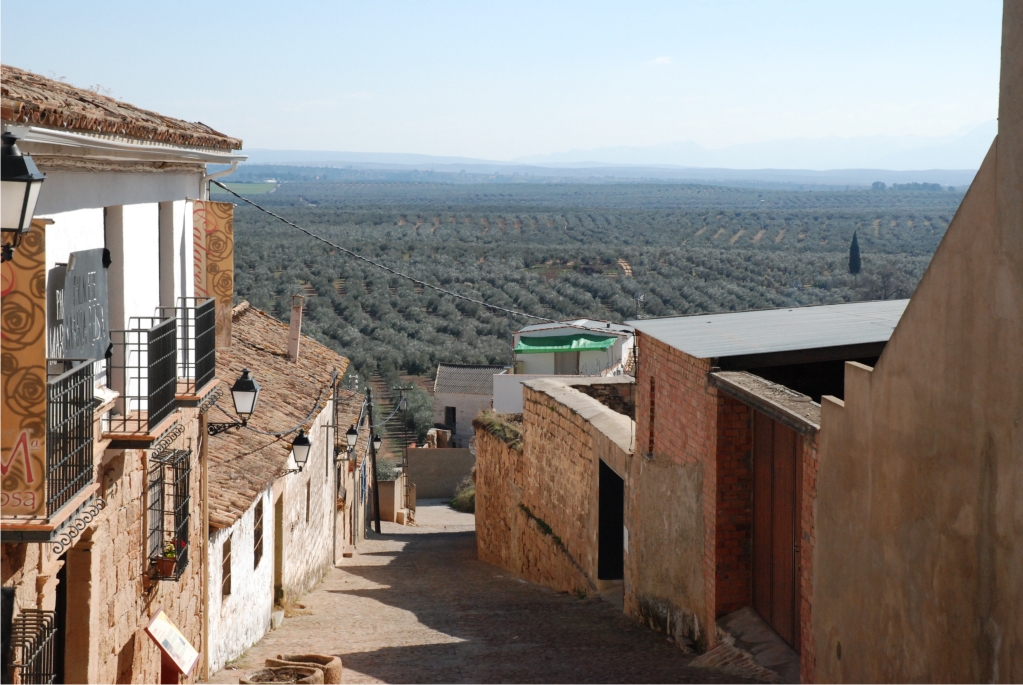
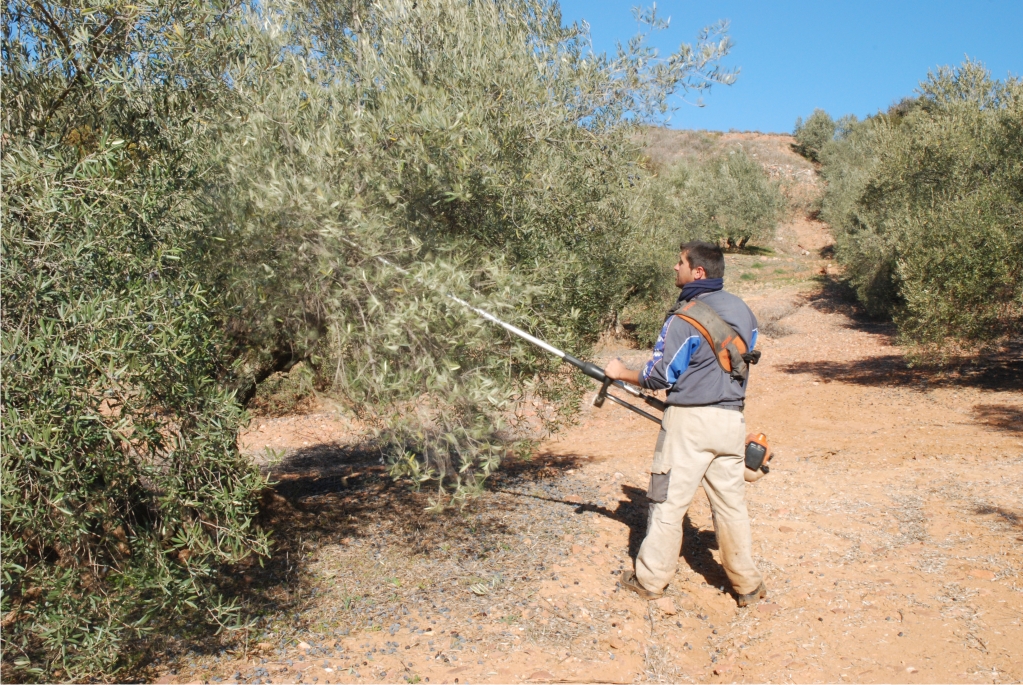

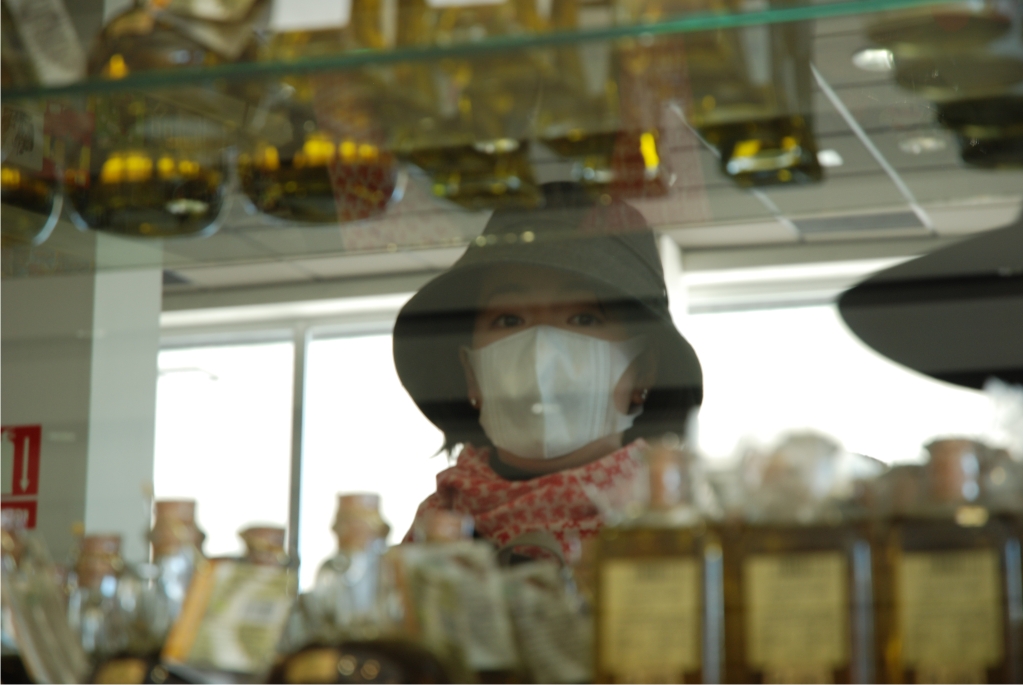
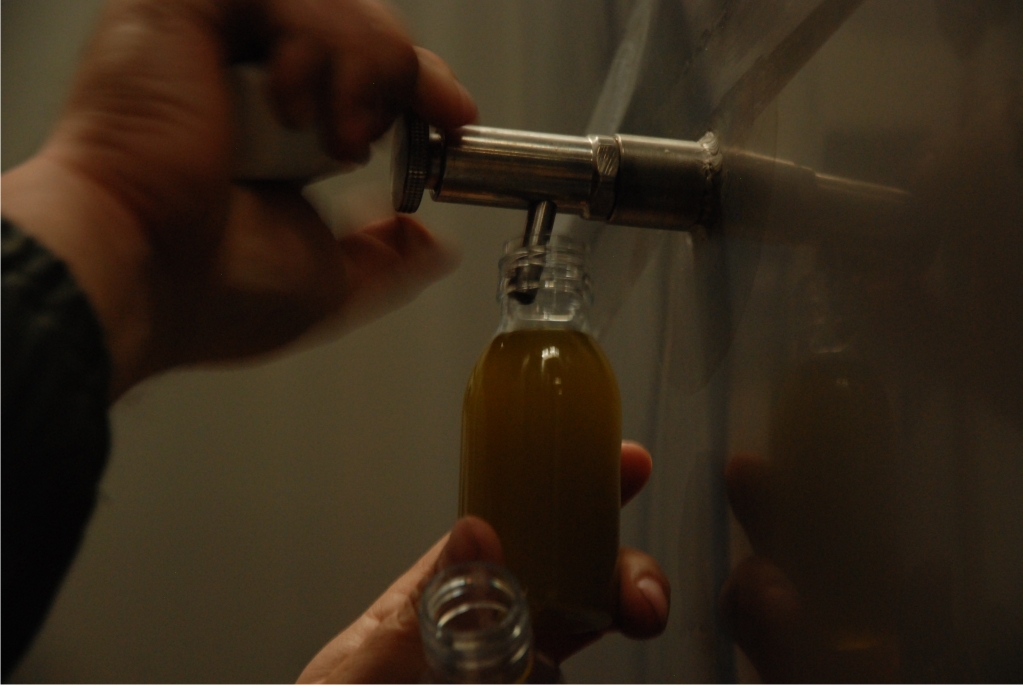

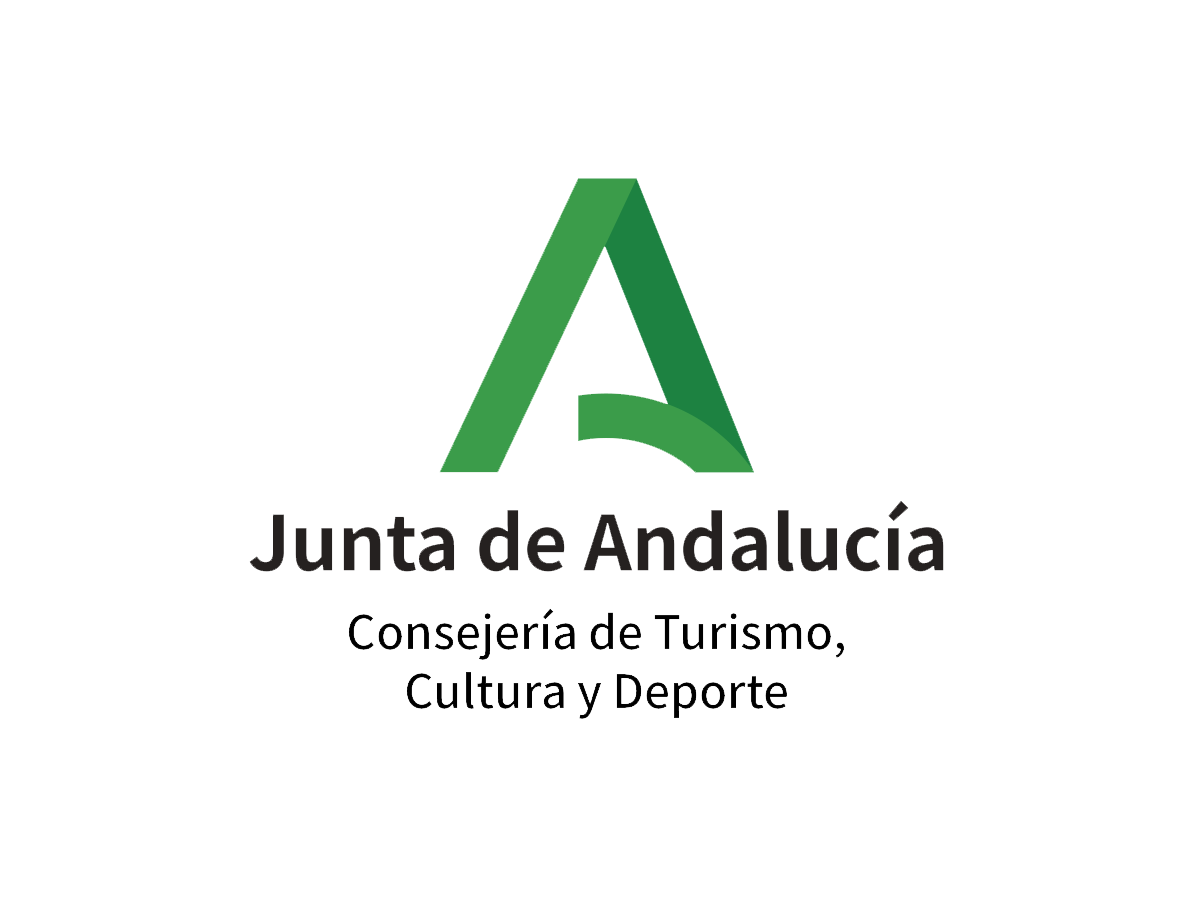




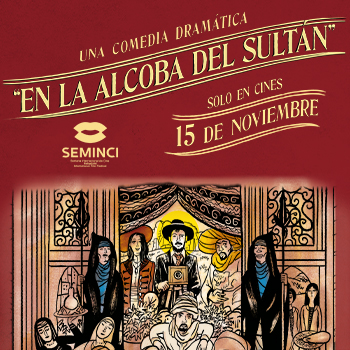

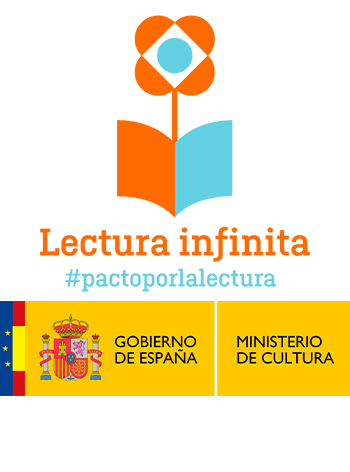
Pingback: Jot Down Cultural Magazine | A la caza del oro líquido